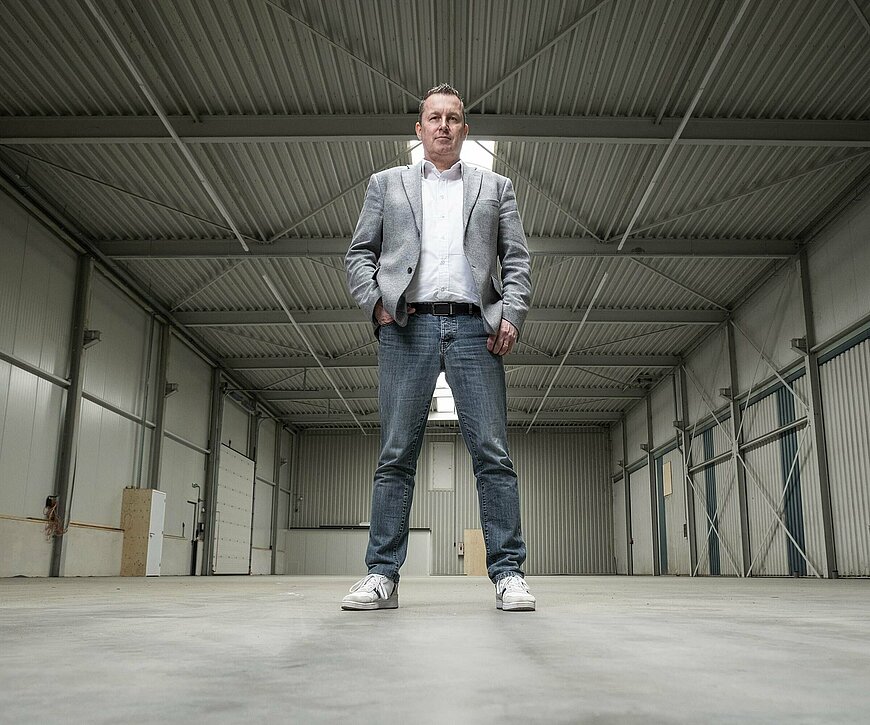Frontrunner in sustainability #2: Occupational clothing that is sustainable and affordable

Does your company want to become more sustainable or do you want to get started with Corporate Social Responsibility? But don't you know how? In this series of stories, we speak with entrepreneurs from the Brainport Eindhoven region who are already well on their way in the transition towards a sustainable economy. What can we learn from these pioneers? This time we speak with Bart Oerlemans, director of Textiel Groep Holland. This year, the company from Bladel will start selling sustainable work clothing which is also affordable.
The clothing industry is one of the most polluting industries in the world. For example, the textile fiber polyester is made from petroleum, chemical coloring is still common and far too much clothing is produced. “The environment pays a high price for this, I am aware of that”, says Bart Oerlemans, director of Textiel Groep Holland. The company that is located in Bladel sells 37 brands of workwear to over 3,000 customers. To the entrepreneurs behind the brands that Bart sells sustainability is a priority. “And of course I also feel responsible for sellings sustainable clothes”, explains Bart. “We therefore check if all relevant certificates are authentic and visit production locations. In this way we know that our brands do what they promise.”
Own clothing line
However sustainable these collections are, customers are not yet very keen to buy them. “The reason is simple,” continues Bart. “Sustainable work clothing is still quite expensive. Many of my clients are not willing to pay the difference. At the bottom of the line, price often trumps sustainability.” That is why, after thirty years of experience, Bart is going to start his own line. “My father always said: what others can do, you can do too. But better. I saw exactly where other brands miss chances and in my case I don’t just talk about it but I take action.” So Bart got to work. The result is the Back2Basics collection. In a few weeks, an immense industrial hall of 3,000 square meters is going to be filled with the first load of T-shirts, polo shirts and sweaters.
Watch what the rest is doing
What choices do you make in developing a clothing line, that make it easier for customers to opt for sustainable work clothing? According to Bart, it all starts with being critical about what other brands don't do. ”A lot of workwear is made of polluting polyester. That can be done in a better way: our line is therefore made of certified cotton and recycled polyester.” Anyone who thinks that this material is less durable is wrong. “The clothing is actually stronger because it is put together in a more solid way. Everything is double stitched, sometimes even triple. This makes clothes last much longer. In addition, the clothes can be washed at 60 degrees, while competitors often recommend 40 degrees. This makes it difficult to remove all stains: a reason to throw a piece of clothing away.”
Production and recycling
Bart's clothing line is produced in a factory in Pakistan. Bart carefully selected that location. “I prefer to produce closer to home, but that is not yet possible in terms of price. I see it as an evolution: things can always be better, but I have to start somewhere.” The factory meets important sustainability certificates, but that is not enough for Bart. “We will soon be installing cameras above the production lines. Through a live stream, customers can see for themselves how neatly we work and that there are no children in the factory. People have to trust your brand: you can only achieve that by being open and honest.”
Another striking sustainable plus of his collection: a piece of clothing from Back2Basics can be returned to Textiel Groep Holland afterwards. “I really missed this option when it comes to the other 37 brands that I sell. The circle is never complete. My discarded garments go to a company that cuts off printing and embroidery. New clothes are made from the fabric that remains.”
Settle for less
Shortly the clothibg line has enough distinguishing features. What about the price then? Sustainability often also means that the costs are higher. Bart is clear about this: “Customers are willing to pay a little more, but I really want to avoid a price difference of 10 to 20 percent. Back2Basics margin is fine, but not immense. That is not necessary though, enough is enough." According to Bart, this is an important tip for entrepreneurs who also want to get started with sustainability. “If earning a lot of money is your main reason for starting your own business, you can forget about sustainability. My advice: settle for a little less. I think it is important that I leave the world in a better state than when I was born.”
Would you also like to become a frontrunner in sustainability? Tips from Bart:
1. Do it yourself and do it better
“This tip really is the most important one. It is my life motto as an entrepreneur. Look at what your competitors are doing and make sure your offer is better. So not faster or cheaper, no: better.”
2. Sustainabilityis a choice
“If money is your number one priority, then sustainability is not for you. A consequence of producing in a more sustainable manner is simply making less margin. That's a choice you can live with or not. This understanding came to me with age. Entrpreneuring to me used to be about making as much profit as possible, now I also think about my grandchildren.”
3. Be critical when it comes to certificates
“Blindly trusting certificates is dangerous. For example, many supposedly sustainable garments are made from recycled PET bottles. But did you know that those PET bottles are often specially produced for the production of clothes? So study certificates and be critical!”
This series of stories is made possible by Brainport Development and Rabobank.